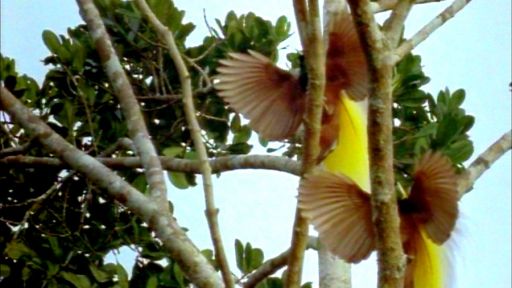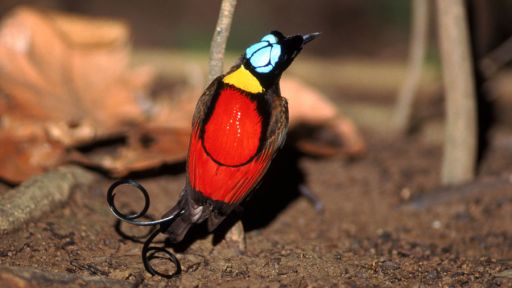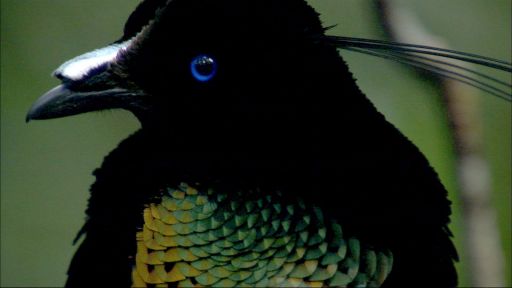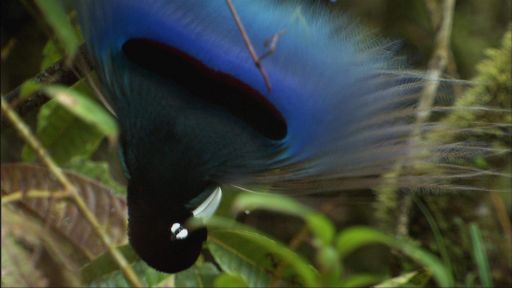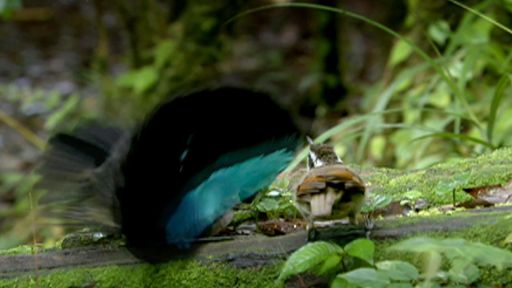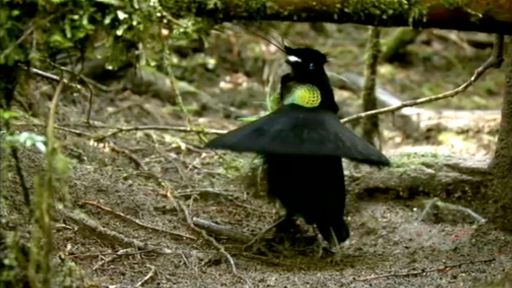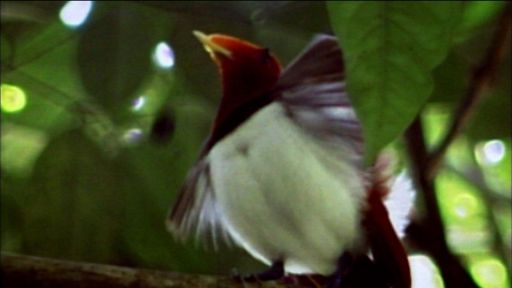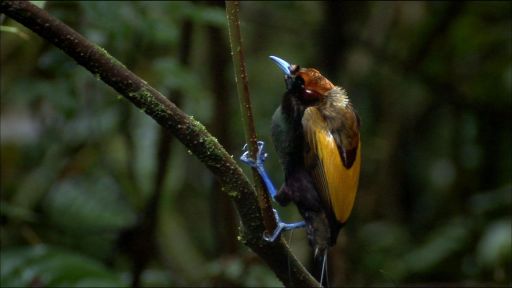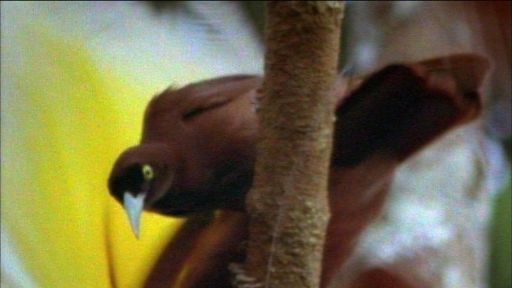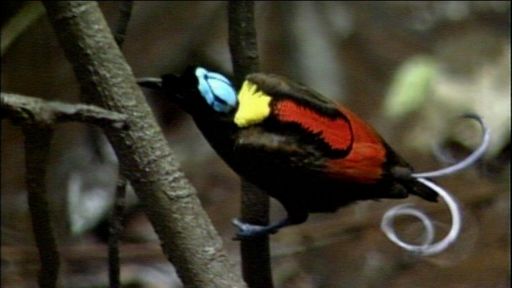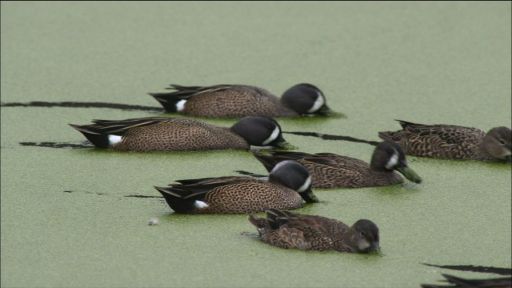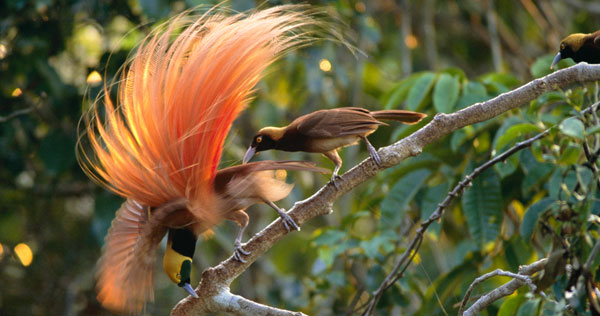
SEXUAL SELECTION: DRESS TO IMPRESS
There are close to forty species of birds of paradise in New Guinea and no two look alike. The Red bird of paradise (Paradisaea rubra) is deep crimson with yellow highlights and has a pair of long wiry quills sprouting from its tail. The Goldie’s bird of paradise (Paradisaea decora) has a yellow and dark green body and large, fluffed crimson plumes on its back. The Ribbon-tailed Astrapia (Astrapia mayeri) is covered in metallic blues and greens with a “streamer” tail that extends over three times the length of its body.
The spectacular plumage that has come to typify the Paradisaeidae family is generally reserved for only the males in the species. Females sport a far more conservative look of lackluster grays and browns.
Females may be drab but we have them to thank for the males’ saturated colors, fuzzy feathers, and streamer tails. Females choose mates based on the condition and color of the males’ plumage. Bright and flashy coloring signals that the male is healthy and will produce healthy offspring. Males puff their feathers, vibrate and buzz – whatever it takes to show off their more colorful assets to a potential mate. Females will choose the most impressive and attractive males based on their displays. Over time, genes associated with these aesthetically pleasing features are passed down and the attributes become more prominent within the species. This process is known as sexual selection. Natural selection is usually about competition for resources, but sexual selection is about competition for mates. On an island with abundant resources and few predators, females are the number one decider in how males evolve.
Sexual dimorphism, strong physical distinctions between the sexes, is not found in all birds of paradise. All five birds in the Manucodia genus are monomorphic, with almost no plumage variation between the sexes. These species are also monogamous. One possible explanation for this is related to diet. Species where males and females share coloring tend to feed on less nutritious simple fruits like figs. Males must work with females to forage and successfully raise young, leaving no time for outside courtships. This isn’t an issue for species that eat a diverse and reliable diet of fruits and insects. Females are able to raise hatchlings alone, freeing up the male to court other females with his magnificent and much-needed plumage.
SEXUAL SELECTION: DANCE DANCE EVOLUTION
They hop, swing, strut, shake and buzz, and even transform their bodies into strange, geometrical abstractions. Although the types of movements vary between species, nearly all male birds of paradise use movement to woo potential mates.
Carola Parotia (Parotia carolae), Superb bird of paradise (Lophorina superba), and Blue bird of paradise (Paradisaea rudolphi) all have wildly different displays they perform for their female counterparts. During the Carola Parotia dance, males lift their flank feathers to form a tutu-like skirt and hop and waggle across the forest floor. Superb bird of paradise snap their breast shield and back plumes into a complete physical transformation, creating an ellipse of blue and black feathers around their head. Resembling nothing like a bird, they hop around the females, rhythmically snapping their tail feathers as they go. Blue bird of paradise hang upside down from the branches, pulsating with their blue and violet feathers spread out like a fan. During the show, Blue bird of paradise produce a low, soft buzzing sound.
Similar to their plumage, these dance moves evolved over time, based on the subtle tastes of the females in the species. If females mate exclusively with males that perform specific types of movements, eventually that display performance will become commonplace.
Recent scientific research examines these mating displays and what they can tell us about the evolutionary process. According to ornithologist Edwin Scholes III, these complex courtship performances can be broken down into a series of smaller, individual movements. These building blocks of motion are combined to form a single choreographed piece. By simply reorganizing and modifying these steps, males can create novel performances. Scholes argues that modularity can enhance and speed up the evolutionary process by allowing new behaviors to develop quickly through the reorganization of already existing parts. If females prefer those new organizations, then those displays will eventually become increasingly standard within the species.
Modularity can help chart the evolution of the Paradisaeidae family. If we understand how these dances are related to each other, we can identify which bird of paradise species are more closely related. As lineages become clearer, we can gain new insights into how sexual selection of both behavioral and physical traits function and evolve within the family.

